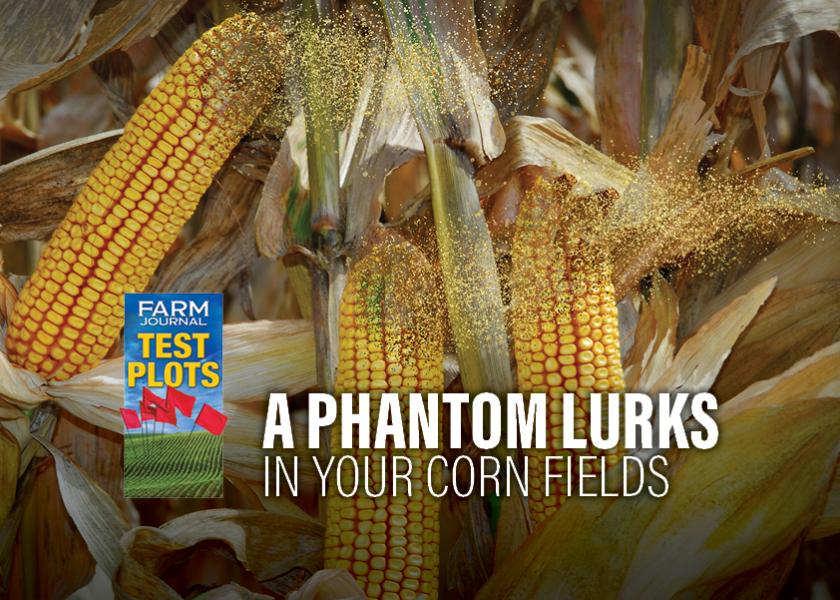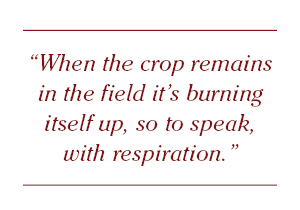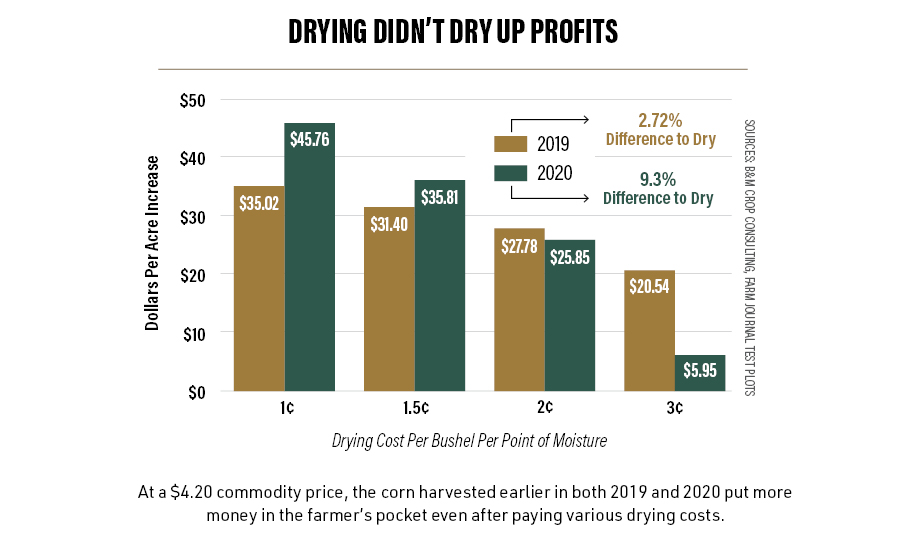Farm Journal Test Plots: A Phantom Lurks in Your Corn Fields

As harvest approaches, it’s important to recognize there’s an invisible enemy lurking in your corn fields. Phantom yield loss occurs when a crop is allowed to naturally dry down to a certain point before harvest.
Does the elusive dry matter lost equate to bushels? If so, is it enough to justify switching up harvest timing and paying for drying? Those are the questions Farm Journal Field Agronomist Missy Bauer set out to answer in 2019 and 2020.
Today’s genetics have changed, Bauer explains, and kernels are taller, wider and deeper.

“I’ll date myself, but when I graduated from Purdue, we divided yield calculations by 90,000 kernels per bushel,” Bauer says. “In 2018 and 2019, our hybrid plots averaged 70,000 kernels. In 2020, because of the dry weather, we’re a little higher at 76,000, but that’s nowhere near 90,000. That means kernels are different today than in years past.”
Kernel is Alive
When studying if phantom yield loss is a bigger issue today, with fewer kernels per bushel, Bauer learned several key takeaways.
“Even though the crop is at the black layer stage, the kernel is still alive, and that kernel is going to continue to go through respiration, which can result in the loss of kernel weight,” she explains. “Basically, the weight loss is a result of the metabolic activity within the kernel.
“That kernel is going to remain alive until we kill it with heat. When you dry it down in your dryer to 15%, then we’re basically killing it at that point,” Bauer adds.
When the crop remains in the field it’s burning itself up, so to speak, with respiration. That’s the concept of phantom yield loss.
Combine is Not to Blame
When studying phantom yield loss, Bauer and her team monitored harvest loss counts on the ground. They found no difference when comparing the earlier versus later harvest dates. It wasn’t that as the corn dried down there was more shatter and shelled at the head and more kernels on the ground. The difference came from phantom yield loss.
In 2020, Bauer selected one hybrid in an irrigated field to study in terms of phantom yield loss. 
A portion of the field was harvested early, on Sept. 23, when the stalks were still green to a large extent. On Oct. 30, the remainder of the field was harvested, which was a little later than Bauer preferred, but that’s how harvest goes some years.
On average, the corn harvested early had a yield advantage of 15.6 bu. per acre at 214.2 bu. versus 198.6 bu. for the corn harvested in late October. Across management zones, the earlier harvest yielded from 11.6 bu. to 22.4 bu. more.
When it comes to moisture levels, the corn harvested on Sept. 23 was at 27.9%. By Oct. 30, moisture levels fell to 18.4%. That 9.3 points in moisture dried “for free” in the field.

Obviously, an early harvest means drying corn is necessary. That can cost from 1¢ to 4¢ per bushel per point of moisture, depending on on-farm or elevator options.
At the time, corn was at $4.20 per bushel. After paying the drying cost, the corn harvest in late September made money — anywhere from $5.95 to $45.76 per acre, depending on drying costs.

In 2019, there was nothing early about harvest after a late start to planting due to the wet weather. For Bauer, early harvest occurred Oct. 29 and late harvest was Nov. 18. With three weeks difference, the late October harvest had a 10.6-bu. advantage (266.4 bu. versus 255.8 bu.) with a 2.7% difference in moisture.
“In terms of economics, at 1.5¢ for drying costs per bushel per point we put $31.40 an acre back in the farmer’s pocket,” Bauer says. “Even at 4¢ per bushel per point drying costs, he still made money.”
Take Advantage of Half-price Drying
When considering drying costs, don’t forget some elevators and ethanol plants will offer half-price drying in early fall.
“In September and sometimes even the first few days of October, elevators and ethanol plants in our area in Michigan need corn, so they’ll offer half-price drying. Take advantage of that,” Bauer says.
There’s also something to be said about starting harvest earlier. Take advantage of warmer weather, Bauer adds, and stretch out the harvest window to ease up on logistics when there’s not enough hours in a day.
Thank You to Our Plot Partners
BASF, Bayer Crop Science, Pioneer, Case IH, Clarks Ag Supply, Great Plains, Kinze, New Holland, Unverferth, AirScout, Trimble, B&M Crop Consulting, Finegan Farms and Welden Farms







